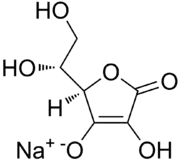Sodium erythorbate
Sodium erythorbate (C6H7NaO6) is a food additive used predominantly in meats, poultry, and soft drinks. Chemically, it is the sodium salt of erythorbic acid. When used in processed meat such as hot dogs and beef sticks, it increases the rate at which nitrite reduces to nitric oxide, thus facilitating a faster cure and retaining the pink coloring. As an antioxidant structurally related to vitamin C, it helps improve flavor stability and prevents the formation of carcinogenic nitrosamines. When used as a food additive, its E number is E316.[3] The use of erythorbic acid and sodium erythorbate as a food preservative has increased greatly since the U.S. Food and Drug Administration banned the use of sulfites as preservatives in foods intended to be eaten fresh (such as ingredients for fresh salads) and as food processors have responded to the fact that some people are allergic to sulfites.[4] It can also be found in bologna, and is occasionally used in beverages, baked goods, and potato salad.[5]
 | |
| Names | |
|---|---|
| IUPAC name
Sodium 5-(1,2-dihydroxyethyl)-3-hydroxy-4-oxofuran-2-olate | |
| Other names
D-Isoascorbate; Erythorbic acid, sodium salt; E316; Araboascorbic acid, monosodium salt, D- (6CI); D-erythro-Hex-2-enonic acid, γ-lactone, monosodium salt (8CI,9CI); Erbit N; Eribate N; Isoascorbate C sodium; Isona; Sodium isoascorbate | |
| Identifiers | |
3D model (JSmol) |
|
| ChEBI | |
| ChemSpider | |
| ECHA InfoCard | 100.026.340 |
| EC Number |
|
| E number | E316 (antioxidants, ...) |
PubChem CID |
|
| UNII | |
CompTox Dashboard (EPA) |
|
| |
| |
| Properties | |
| C6H7NaO6 | |
| Molar mass | 198.11 g/mol |
| Appearance | White crystalline solid |
| Melting point | 168 to 170 °C (334 to 338 °F; 441 to 443 K) |
| 16 g/100 mL | |
| Hazards | |
| NFPA 704 (fire diamond) | |
Except where otherwise noted, data are given for materials in their standard state (at 25 °C [77 °F], 100 kPa). | |
| Infobox references | |
Sodium erythorbate is produced from sugars derived from different sources, such as beets, sugar cane, and corn.[6][7][8] An urban myth claims that sodium erythorbate is made from ground earthworms; however, there is no truth to the myth.[9] It is thought that the origin of the legend comes from the similarity of the chemical name to the words earthworm and bait.[9]
Alternative applications include the development of additives that could be utilized as antioxidants in general. For instance, this substance has been implemented in the development of corrosion inhibitors for metals[10] and it has been implemented in active packaging.[11]
Sodium erythorbate is soluble in water. The pH of the aqueous solution of the sodium salt is between 5 and 6. A 10% solution, made from commercial grade sodium erythorbate, may have a pH of 7.2 to 7.9.[12] In its dry, crystalline state it is nonreactive. But, when in solution with water it readily reacts with atmospheric oxygen and other oxidizing agents, which makes it a valuable antioxidant.[5]
References
- Merck Index, 11th Edition, 5009.
- "CAS Registry Number 6381-77-7". SciFinder. Retrieved 14 November 2016.
- Current EU approved additives and their E Numbers, Food Standards Agency
- Hui, Y. H. (2006). Handbook of Food Science, Technology and Engineering. CRC Press. p. 83-32. ISBN 0-8493-9848-7.
- Igoe, R. S. (2011). Dictionary of Food Ingredients. Boston, MA: Springer US. pp. 129.
- "Sodium Erythorbate". PMP Fermentation Products, Inc. Archived from the original on January 11, 2010. Retrieved 2008-10-27.
- "Sodium Erythorbate (Archive Copy - Original not available?)". PMP Fermentation Products, Inc. Archived from the original on January 11, 2010. Retrieved 2011-10-23.CS1 maint: unfit URL (link)
- "Sodium erythorbate".
- Sodium Erythorbate - is it an earthworm?, Oregon Department of Agriculture
- Christensen RJ, Steimel LH, Oxygen scavenger for boiler water and method of use. US patent 4,891,141. 1990
- R. Joven, A. Garcia, A. Arias, J. Medina. Development of an active thermoplastic film with oxygen scavengers made of activated carbon and sodium erythorbate. In: Packaging Technology and Science, Vol 28, No. 2; 01/2015.
- The Merck Index (14th ed.). Merck Research Laboratories. 2006. pp. Page 890, section 5126.
